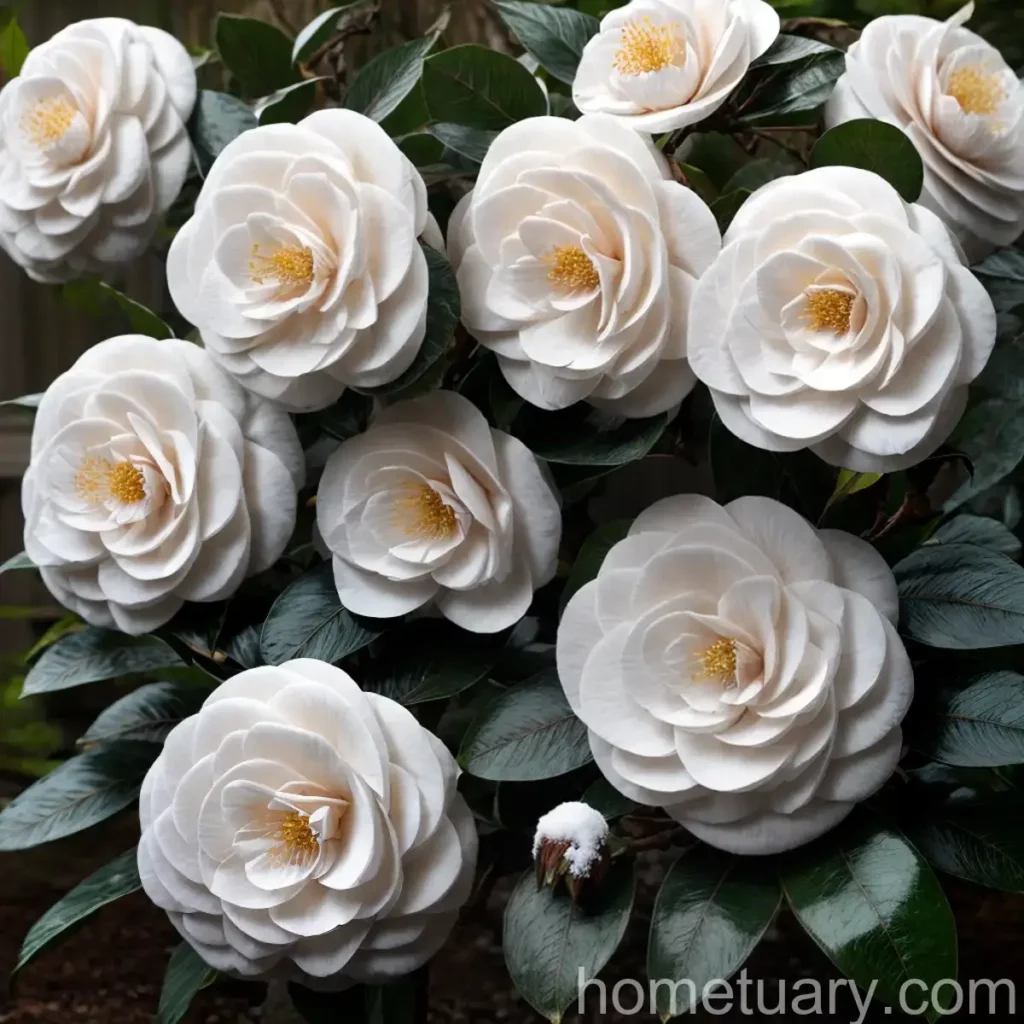Camellia (Camellia japonica ‘April Snow’): A Complete Guide
Camellia japonica, commonly known as camellia, is a fascinating and beautiful evergreen flowering plant. Among numerous cultivars, ‘April Snow’ stands out for its stunning white blooms and vibrant green foliage. In this comprehensive guide, we will explore the intricacies of growing and caring for Camellia japonica ‘April Snow’, from its cultural requirements to common pests and diseases. Whether you are a seasoned gardener or a beginner, these insights will help you foster healthy and thriving ‘April Snow’ camellias in your garden.
What is Camellia (Camellia japonica ‘April Snow’)?
Camellia japonica ‘April Snow’ is a striking cultivar renowned for its radiant, snow-white blossoms that grace gardens in early spring. This captivating evergreen shrub belongs to the Theaceae family and is native to eastern and southern Asia, including China, Japan, Korea, and Taiwan. Its glossy, dark green leaves provide an exquisite backdrop to the delicate blooms, making it a popular choice for garden enthusiasts and landscapers alike.
Key Takeaways – Camellia (Camellia japonica ‘April Snow’)
Before delving into the specifics of caring for Camellia japonica ‘April Snow,’ let’s highlight some essential aspects:
- Cultural Requirements: Understanding the cultural needs of camellias is crucial for their overall health and development.
- Uses: ‘April Snow’ camellias are versatile and can be used in various settings, including gardens and floral arrangements.
- Water: Proper watering is essential to ensure the well-being of camellias, especially during crucial growth stages.
- Sunlight: Understanding the sunlight requirements of ‘April Snow’ camellias is vital for their vitality and flowering.
- Fertilizer: Providing the right nutrients at the appropriate times is crucial for the optimal growth and blooming of camellias.
- Soil: The right soil conditions are essential for establishing strong and healthy root systems in ‘April Snow’ camellias.
- Pruning: Pruning techniques play a significant role in shaping the growth and appearance of camellias, including ‘April Snow.’
- Propagation: Learning about propagation methods allows enthusiasts to expand their camellia collection and share their love for these plants.
- Container Popularity: ‘April Snow’ camellias are also suitable for container gardening, offering versatility in placement and design.
- Common Diseases and Pests: Understanding and addressing potential health challenges is essential for maintaining thriving ‘April Snow’ camellias.
With these key takeaways in mind, let’s explore the specific insights into the care and cultivation of Camellia japonica ‘April Snow.’
Culture of Camellia (Camellia japonica ‘April Snow’)
Successful cultivation of Camellia japonica ‘April Snow’ begins with an understanding of its cultural requirements. Creating an environment that mimics its natural habitat ensures the plant’s vigor and abundant flowering. Here are the cultural aspects to consider:
Water
- Watering Needs: Camellias, including ‘April Snow,’ require consistent moisture, especially during their active growth periods. Ensuring adequate watering, particularly during the establishment phase, promotes healthy root development and lush foliage.
- Signs of Overwatering: Excessive moisture can lead to root rot and other detrimental conditions. Watch for signs of overwatering, such as yellowing leaves and wilting.
Sunlight
- Light Conditions: ‘April Snow’ camellias thrive in partial shade to filtered sunlight. Protecting them from intense midday sun and providing dappled light promotes optimal growth and prevents leaf scorching.
- Shade Tolerance: While they prefer filtered light, camellias also exhibit good shade tolerance, making them suitable for gardens with varying light conditions.
Fertilizer
- Fertilization Schedule: Providing a balanced, acidic fertilizer formulated for camellias is essential for their overall health and prolific blooming. Applying fertilizer in early spring supports the development of flower buds and robust growth.
- Avoiding Excess Nitrogen: While camellias benefit from regular fertilization, excessive nitrogen can lead to lush foliage at the expense of flowering. Selecting a fertilizer with a lower nitrogen content helps maintain a healthy balance.
Soil
- Soil Requirements: Well-draining, acidic soil with a pH range between 6.0 and 6.5 provides an ideal growing medium for ‘April Snow’ camellias. Amending the soil with organic matter enhances its structure and fertility, supporting the plant’s root system.
Pruning Camellia (Camellia japonica ‘April Snow’)
Pruning is a valuable practice in shaping the growth of ‘April Snow’ camellias and promoting their overall health. Understanding the timing and techniques for pruning is essential for achieving desired forms and abundant flowering.
Pruning Guidelines
- Timing: The best time to prune ‘April Snow’ camellias is shortly after their flowering period, typically in late spring or early summer. This allows sufficient time for the development of new growth and flower buds for the following year.
- Maintenance Pruning: Regular removal of dead or damaged branches helps maintain the plant’s vigor and appearance. Additionally, thinning out crowded growth encourages air circulation and reduces the risk of disease.
Pruning Techniques
- Removing Spent Blooms: Deadheading faded flowers not only enhances the plant’s aesthetic appeal but also prevents the formation of seed pods, diverting the plant’s energy into new growth and future blooms.
- Shaping and Size Control: Depending on the desired size and form, selective pruning can help shape ‘April Snow’ camellias into compact, well-branched specimens or naturalistic, free-form shrubs.
Pruning Mistakes to Avoid
- Pruning in Late Summer or Fall: Late pruning can remove developing flower buds, compromising the following year’s bloom. It also leaves the plant vulnerable to winter damage.
- Overpruning: Excessive removal of healthy growth can stress the plant and diminish its blooming potential. Pruning should focus on targeted maintenance and shaping, rather than extensive trimming.
Propagation of Camellia (Camellia japonica ‘April Snow’)
Propagation offers enthusiasts the opportunity to expand their camellia collection and share these captivating plants with others. Understanding various propagation methods equips individuals with the knowledge to propagate ‘April Snow’ camellias successfully.
Propagation Methods
- Air Layering: This method involves creating a partial incision in a healthy, flexible branch, encasing the wounded portion in moist growing medium, and allowing it to develop roots before severing it from the parent plant.
- Softwood Cuttings: Taking cuttings from young, tender growth in late spring or early summer and providing the right conditions for root development enables the creation of new ‘April Snow’ camellia plants.
Transplanting Tips
- Transplanting Young Plants: When moving young camellia plants, it’s essential to disturb their root systems as little as possible, ensuring they adapt to their new location with minimal stress.
- Established Plant Care: Providing ample water and protection from direct sunlight in the days following transplanting supports the recovery and establishment of ‘April Snow’ camellias in their new environment.
Common Diseases and Pests Affecting Camellia (Camellia japonica ‘April Snow’)
While camellias are relatively low-maintenance plants, they are susceptible to certain diseases and pests. Familiarizing yourself with these potential challenges and their appropriate control measures is crucial for safeguarding the health of ‘April Snow’ camellias.
Common Diseases
- Leaf Spot: Fungal infections can lead to the development of dark, discolored spots on the leaves. Proper air circulation and foliage management help prevent this condition.
- Root Rot: Excessive moisture and poorly draining soil can contribute to root rot, leading to wilting, yellowing foliage, and stunted growth.
Disease Diagnosis
- Symptom Recognition: Promptly identifying and addressing symptoms such as leaf discoloration, wilting, or abnormal growth is essential for implementing targeted treatment measures.
- Fungal Prevention: Proper sanitation, including removing fallen leaves and debris, and avoiding overhead watering help prevent fungal diseases in ‘April Snow’ camellias.
Common Pests
- Aphids: These small, sap-sucking insects can infest tender shoot tips and buds, leading to distorted growth and a sticky residue known as honeydew.
- Scale Insects: These pests appear as small, raised bumps on the stems and undersides of leaves. Their feeding can weaken the plant and lead to yellowing foliage.
Pest Control Methods
- Natural Predators: Encouraging beneficial insects such as ladybugs and lacewings establishes a natural balance, keeping pest populations in check.
- Horticultural Oils: Applying horticultural oils to suffocate pests like scale insects while minimizing harm to beneficial insects.
Botanist’s Tips for ‘April Snow’ Camellias
As a botanist specializing in ornamental plants, I’ve gathered insights and techniques that can further enhance the cultivation and enjoyment of Camellia japonica ‘April Snow.’ These tips are derived from extensive experience and a passion for nurturing exquisite plant species.
Botanist’s Insights
- Mulching Benefits: Applying a layer of organic mulch around the base of ‘April Snow’ camellias helps conserve moisture, maintain even soil temperature, and suppress weed growth.
- Seasonal Care: Observing and adapting care practices to suit seasonal variations ensures the continuous health and vitality of the plants throughout the year.
Fun Facts about Camellia (Camellia japonica ‘April Snow’)
Delving into the realm of interesting and lesser-known facts about ‘April Snow’ camellias adds a delightful dimension to the appreciation of these captivating plants.
- Symbolism: In the language of flowers, white camellias symbolize purity, admiration, and perfection, adding symbolic depth to floral arrangements and gardens.
- Fragrance: While many camellia varieties are known for their vibrant blooms, some also exhibit a subtle, pleasant fragrance, enhancing the sensory appeal of these plants.
Links to External Resources
To further expand your knowledge and appreciation for Camellia japonica ‘April Snow,’ I recommend exploring the following external resources:
- American Camellia Society
- Royal Horticultural Society: Camellias
- University of Florida Extension: Camellias
In conclusion, the cultivation and care of Camellia japonica ‘April Snow’ encompass a nuanced blend of art and science, offering enthusiasts a rewarding journey filled with vibrant blooms, lush foliage, and the joy of nurturing these exquisite plants. By embracing the insights and practices shared in this guide, you can create a thriving environment for ‘April Snow’ camellias, enriching your outdoor space with their timeless elegance and natural charm.















